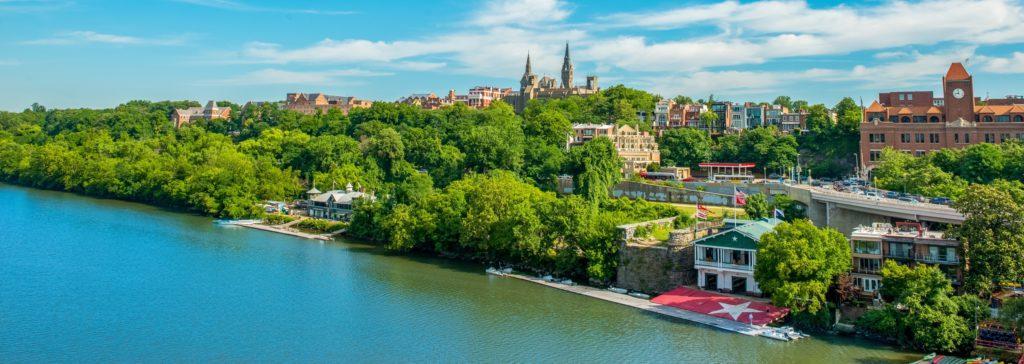D.C. Water will begin performing construction work in the first week of February on and near the Georgetown University campus as part of the Potomac River Tunnel Project.
The project will provide long-term environmental and health benefits in addition to reducing pollution in the Potomac river, according to a Jan. 26 email sent by the Office of Planning and Facilities Management to Georgetown community members.

“The university is partnering with DC Water on this next major stage of the DC Clean Rivers Project, which will provide long-term environmental and health benefits,” according to the email.
The construction project will provide the Potomac with a large-diameter deep sewer tunnel near Georgetown that will transport sewer overflows to the Blue Plains Advanced Wastewater Treatment Plant, according to the project website. This will reduce the amount of sewage overflow by over 93%.
The river tunnel project is one phase of the Clean Rivers Project run by D.C. Water, D.C.’s authority on water and sewers. The goal of the Clean Rivers Project is to reduce sewage overflows into the Potomac, with construction sites including West Potomac Park, below the Kennedy Center and the Capital Crescent trail.
Construction work along Canal Rd. and Prospect St., near Georgetown’s campus, will begin around Feb. 1 and are projected to continue until April.
“The Potomac River Tunnel Project construction is not expected to significantly impact campus life beyond the planned single-lane traffic management during off-peak hours,” Project Manager of Planning and Facilities Management at Georgetown Nico Hohman wrote in a statement to The Hoya.
According to an email to community members, the Canal Road entrance to campus will be reduced to one lane from Feb. 1 to March 20, with flaggers to direct traffic during peak hours. The Prospect street entrance will be reduced to one lane from Feb. 1 to Feb. 14 and again from March 21 to April 10.
There will be alternative pathways in place for pedestrians accessing these roads, according to Hohman. The University also plans to monitor the construction in case it becomes disruptive to student life, especially for those living in dorms near the construction site.
“We will have noise and vibration monitoring in place to adjust work if it becomes too loud or disruptive at any point,” Hohman wrote.
Georgetown women openweight rower Laurel Aronson (CAS ’24) said the pollution problems with the Potomac are unavoidable as an athlete.
“We pull our boats out of the water covered with toxic algae, clumps of plastics line the shores and populate the water,” Aronson wrote to The Hoya. “When the rainfall is heavy enough, a light comes on to indicate when raw sewage is pumped directly into the Potomac”
Aronson said the improvements made through the D.C. Rivers Project could noticeably improve the river.
“I hope that this construction will ameliorate these issues,” Aronson said.
As of now, D.C.’s Potomac river has been notoriously unsafe for swimming and fishing, although there have been recent efforts by the Potomac Riverkeeper Network to reverse the swimming ban. According to the Potomac report card, which tracks changes in the Potomac’s overall health, the river currently scores a “B-” compared to a “B” in 2018 and a “D” in 2011.
The largest contributor to the Potomac’s pollution level is Combined Sewer Overflows (CSO). An estimated 654 million gallons of CSOs containing raw sewage enter the potomac in a year of average rainfall, according to the Potomac river tunnel project website.
CSOs arise because stormwater and sewage in D.C. are collected in the same pipes and tunnels. D.C.’s higher rainfall in recent years due to climate change has led to these systems overflowing into the river.
CSOs reduce overall water quality by allowing bacteria to thrive from the nutrients in wastewater. This results in lower levels of oxygen in the water, which in turn harms fish populations and other aquatic life and increases the amount of trash in waterways.
Improvements to the Potomac’s health through the River Tunnel will also have downstream effects on the Chesapeake bay, including a 1 million pound reduction of nitrogen glowing into the Chesapeake bay and a 98% reduction in CSO to the Anacostia river.
Nejm Benessaiah, a professor in the department of anthropology who studies climate change and the everyday politics of water, says we should all be aware of the issues facing D.C.’s waterways.
“A lot of water and climate issues are happening right here, right now, we just have to look at them,” Benessaiah said in an interview with The Hoya.
Benessaiah says it’s also important to highlight environmental successes and efforts, however, to keep a positive outlook on environmental issues.
“This is beyond just environmental, this affects everybody now,” Benessaiah said. “It is important to highlight that communities or institutions can work together for successes.”








